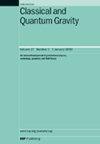引力非最小耦合理论中暗能量模型的相空间分析
IF 3.6
3区 物理与天体物理
Q2 ASTRONOMY & ASTROPHYSICS
引用次数: 0
摘要
我们分析了标量场暗能量模型与引力的最小耦合和非最小耦合,并假设了广义相对论、远平行理论和对称远平行理论中的类yukawa相互作用项的形式等效。我们的分析是在两个标量场表示中进行的,其中精粹和幻影图像与准精粹和准幻影奇异场相关联。在后者中,我们建议如何在不显示直接动力学项的情况下建立光子压力。因此,稳定性分析表明,这一准精粹场提供了一种可行的宇宙描述,表明在最小耦合时,如何通过显示一个吸引点来统一暗能量和暗物质。相反,在非最小耦合中,替代场只留下暗能量占主导地位的吸引子,模仿事实上的宇宙常数行为。通过对标准情况和备选情况的直接比较,得出了在所有重力情况下,精萃的行为都得到了很好的建立。然而,考虑到幻场与引力的非极小耦合,对于爱因斯坦理论中的幂律势,以及远平行理论和对称远平行理论中的平方反比势,结果都是不确定的。最后,我们研究了物质扰动的增长,并建立了只有五次幂和二次势,当用于描述与重力最小耦合的准幻场时,表现出与ΛCDM模型相似的行为。本文章由计算机程序翻译,如有差异,请以英文原文为准。
Phase-space analysis of dark energy models in non-minimally coupled theories of gravity
We analyze scalar field dark energy models minimally and non-minimally coupled to gravity, postulating that a Yukawa-like interacting term is in form equivalent for general relativity, teleparallel and symmetric-teleparallel theories. Our analysis is pursued within two scalar field representations, where a quintessence and phantom pictures are associated with quasiquintessence and quasiphantom exotic fields. In the latter, we suggest how the phion-pressure can be built up without exhibiting a direct kinetic term. Accordingly, the stability analysis reveals that this quasiquintessence field provides a viable description of the Universe indicating, when minimally coupled, how to unify dark energy and dark matter by showing an attractor point where . Conversely, in the non-minimally coupling, the alternative field only leaves an attractor where dark energy dominates, mimicking de facto a cosmological constant behavior. A direct study is conducted comparing the standard case with the alternative one, overall concluding that the behavior of quintessence is well established across all the gravity scenarios. However, considering the phantom field non-minimal coupled to gravity, the results are inconclusive for power-law potentials in Einstein theory, and for the inverse square power potential in both teleparallel and symmetric-teleparallel theories. Finally, we study the growth of matter perturbations and establish that only the fifth power and quadratic potentials, when used to describe quasiphantom field minimally coupled to gravity, exhibit behavior similar to the ΛCDM model.
求助全文
通过发布文献求助,成功后即可免费获取论文全文。
去求助
来源期刊

Classical and Quantum Gravity
物理-天文与天体物理
CiteScore
7.00
自引率
8.60%
发文量
301
审稿时长
2-4 weeks
期刊介绍:
Classical and Quantum Gravity is an established journal for physicists, mathematicians and cosmologists in the fields of gravitation and the theory of spacetime. The journal is now the acknowledged world leader in classical relativity and all areas of quantum gravity.
 求助内容:
求助内容: 应助结果提醒方式:
应助结果提醒方式:


